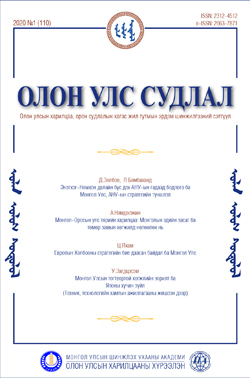The Defining the principles of nationalism of Chinese historians in relation to modern Mongolian history
DOI:
https://doi.org/10.5564/jis.v1i110.1347Keywords:
Mongolia, China, Three Principles of the PeopleAbstract
In this article, we tried to discuss on the ideological background that “Mongolia was part of China (中国)”. This idea is repeated in the academic publications about contemporary Mongolian history in the Peoples’ Republic of China. According to the first principle “Nationalism” of the “Three Principles of the People” by Sun Yat-sen (Sun Zhongshan), mongolians are one of five nations in China (中国). But, this idea doesn’t correspond with the real conditions of Mongolian and Chinese (中国)history. Chinese historians’ conception of the term of China (中国) as Qing dinasty (清朝) was one of main causes of historical misunderstanding between Mongolian and Chinese historians.
Монголын орчин үеийн түүхийн талаар БНХАУ-ын түүхчдийн баримталж буй үндэстний зарчмыг шүүмжлэх нь
Хураангуй: Энэхүү өгүүлэлд БНХАУ дахь Монголын орчин үеийн түүхийн талаар нийтлэгдсэн бүтээлүүдэд олонтаа давтагддаг “Монгол бол Дундад улсын алдагдсан нутаг юм” хэмээх үзлийн онолын үндсийг хөндөхийг оролдов. Сунь Ятсений “Ардын гурван зарчимд” буй таван үндэстний бүгд найрамдах улсын тухай ойлголт нь Монгол улсыг Хятадын(中国)алдагдсан нутаг хэмээн үзэхэд хятадын түүхчдийг хүргэжээ. Орчин үеийн түүхийг судалж буй хятадын түүхчид ийнхүү Хятад(中国)хэмээх ойлголтыг манжийн Чин улсын хэмжээнд буцаан хэрэглэж буй явдал нь Монгол, Хятадын түүхийн салбар дахь үл ойлголцлын шалтгаан болж байна.
Түлхүүр үгc: Монгол улс, Хятад улс, Ардын гурван зарчим
Downloads
1964
Downloads
Published
How to Cite
Issue
Section
License
Copyright on any research article in the Journal of International Studies is retained by the author(s).
The authors grant the Journal of International Studies a license to publish the article and identify itself as the original publisher.

Articles in the Journal of International Studies are Open Access articles published under a Creative Commons Attribution 4.0 International License CC BY.
This license permits use, distribution and reproduction in any medium, provided the original work is properly cited.




